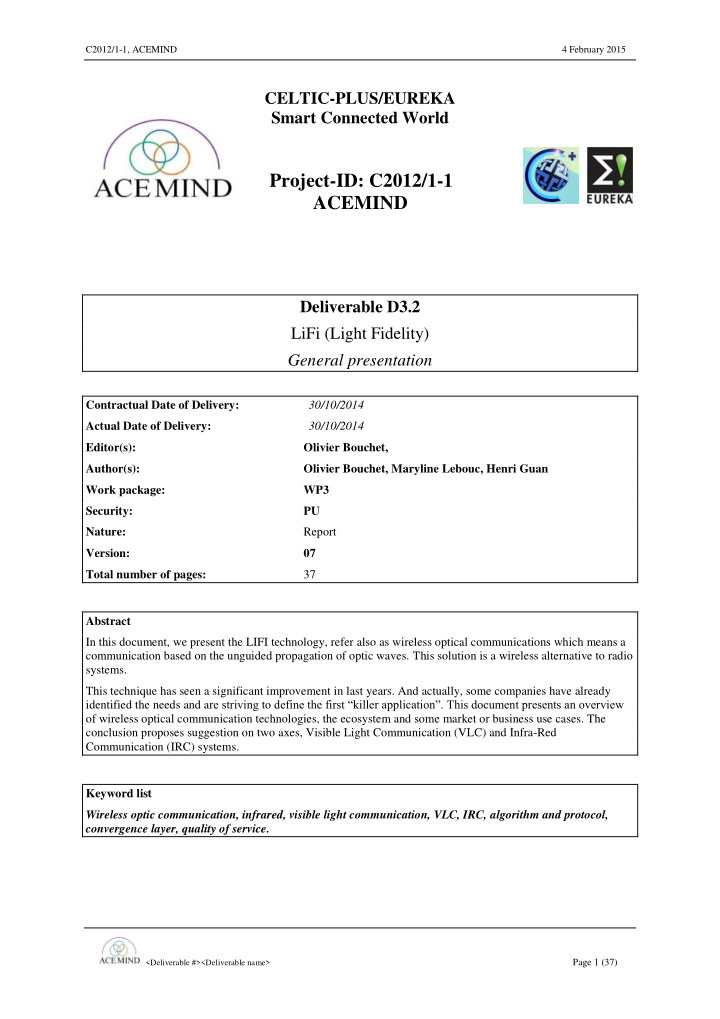



C2012/1-1, ACEMIND 4 February 2015 CELTIC-PLUS/EUREKA Smart Connected World Project-ID: C2012/1-1 ACEMIND Deliverable D3.2 LiFi (Light Fidelity) General presentation Contractual Date of Delivery: 30/10/2014 Actual Date of Delivery: 30/10/2014 Editor(s): Olivier Bouchet, Author(s): Olivier Bouchet, Maryline Lebouc, Henri Guan Work package: WP3 Security: PU Nature: Report Version: 07 Total number of pages: 37 Abstract In this document, we present the LIFI technology, refer also as wireless optical communications which means a communication based on the unguided propagation of optic waves. This solution is a wireless alternative to radio systems. This technique has seen a significant improvement in last years. And actually, some companies have already identified the needs and ar e striving to define the first “killer application”. This document presents an overview of wireless optical communication technologies, the ecosystem and some market or business use cases. The conclusion proposes suggestion on two axes, Visible Light Communication (VLC) and Infra-Red Communication (IRC) systems. Keyword list Wireless optic communication, infrared, visible light communication, VLC, IRC, algorithm and protocol, convergence layer, quality of service. <Deliverable #><Deliverable name> Page 1 (37)
C2012/1-1, ACEMIND 4 February 2015 Executive Summary Wireless optical communications refer to communication based on the unguided propagation of optic waves. Currently, this technique has seen a significant improvement in two main areas: outdoor applications, i.e. Free Space Optic (FSO), communications between satellites or ground/air transmission, indoor application like the remote controller or IrDA point to point communication. Orange Labs have investigated the potential for point to multipoint indoor application of this technology using open innovation (collaborative French project “Techimage” and European project “Omega”). Demonstrators have been developed, proving the concept and feasibility but still technically behind radio solutions, which benefit from a mature and solid market. Nevertheless, Wireless Optical Network (WON) remains a wireless alternative to radio systems and could gain attractiveness thanks to its recognized immunity, regulated by international standard, or in case of saturation of the radio spectrum. Actually, some companies have already identified the needs for an alternative solution to radio and are striving to define the first “killer application”. There is no so much company who have available commercial product but OLEDCOMM starts their commercial product in the end of 2013.This Company has realized several project for the different companies in different business sectors and sale product for lighting companies, as we described in Section 3. This document presents an overview of wireless optical communication technologies, the ecosystem and some market or business use cases. The conclusion proposes suggestion on both axes, Visible Light Communication (VLC) and Infra-Red Communication (IRC) systems. <Deliverable #><Deliverable name> Page 2 (37)
C2012/1-1, ACEMIND 4 February 2015 List of Authors First name Last name Beneficiary Email address Olivier Bouchet Orange Labs olivier.bouchet@orange.com Maryline Lebouc Orange Labs maryline.lebouc@orange.com Henri Guan Oledcomm hongyu.guan@oledcomm.com Document History First name Last name Version Comments Olivier Bouchet 1.0 Creation Olivier Bouchet 2.1 Modification <Deliverable #><Deliverable name> Page 3 (37)
C2012/1-1, ACEMIND 4 February 2015 List of Acronyms Acronym Meaning <Advanced Convergent and Easily Manageable Innovative Networks <ACEMIND> Design> AC alternating current ACK acknowledgement ADSL asymmetric digital subscriber line ANSI American National Standards Institute AP access point BPSK binary phase shift keying CDMA Code Division Multiple Access CE consumer electronics CO confidential CPE customer premises equipment CSMA carrier sense multiple access CSMA/CA carrier sense multiple access collision avoidance CSMA/CD carrier sense multiple access collision detection DSL Digital Subscriber Line DVB digital video broadcasting EC European Commission EMC electromagnetic compatibility EN European norm EU European Union FCC Federal Communications Commission Gbps Gigabit per second GHz Gigahertz HD high definition HDTV high definition television HGI Home Gateway Initiative HILI High Level Interface HIP Host Identity Protocol HN home networking HSI high speed interface HW hardware <Deliverable #><Deliverable name> Page 4 (37)
C2012/1-1, ACEMIND 4 February 2015 HWMP Hybrid Wireless Mesh Protocol ICT information and communications technologies ID identifier IEC International Electrotechnical Commission IEEE Institute of Electrical and Electronics Engineers IEEE-SA IEEE Standards Association IETF Internet Engineering Task Force IP Internet Protocol IPTV internet protocol television IR infrared IrDA Infrared Data Association ISM industrial, scientific, and medical ISO International Organization for Standardization IT information technology ITE information technology equipment ITU-T International Telecommunication Union - Telecommunication Standardization Sector JEITA Japan Electronics and Information Technology Industries Association JTC joint technical committee L3MP Layer 3 Mobility Prediction LAN local area network LDPC low density parity check LiFi Light Fidelity LLC Logical Link Control MAC media access control Mbps Megabit per second MHz Megahertz MIB management information base MIMO multiple input multiple output MIP Mobile IP MIPv4 Mobile Internet Protocol version 4 MIPv6 Mobile Internet Protocol version 6 OFDM orthogonal frequency division multiplexing PAR project authorization request PC personal computer <Deliverable #><Deliverable name> Page 5 (37)
C2012/1-1, ACEMIND 4 February 2015 PHY physical layer PLC powerline communication QAM quadrature amplitude modulation QoS quality of service QPSK quadrature phase shift keying SC single carrier; study committee SME small and medium enterprise SOHO small office / home office Std standard SW software TC technical committee TCP Transport Control Protocol TDMA time division multiple access TG task group TS technical specification TV television UM usage model USB universal serial bus USB-IF USB implementers forum VDSL very high speed digital subscriber line VHT very high throughput VLAN virtual local area network VLC visible light communications VLCC Visible Light Communications Consortium VoIP voice over internet protocol WCDMA Wideband Code Division Multiple Access WG working group Wi-Fi wireless fidelity WLAN wireless local area network WMM Wi-Fi Multimedia WP workpackage WPA wireless protected access WPAN wireless personal area network xDSL any DSL technology <Deliverable #><Deliverable name> Page 6 (37)
Recommend
More recommend